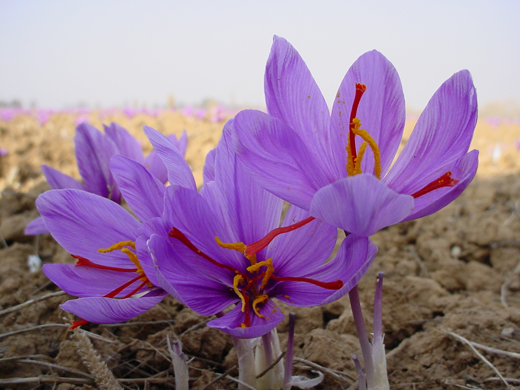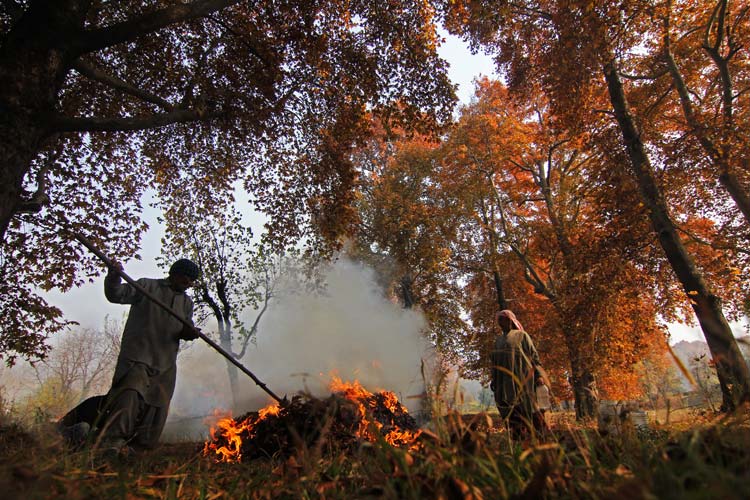Kashmir is home to one of the rarest and most expensive spices in the world: Saffron. Shams Irfan walks through the historic fields of Pampore.
 In October the otherwise sleepy town of Pampore comes to life as the surrounding Karewas get carpeted with saffron flowers. Thousands of tourists from India and abroad visit the state in mid-October in order to see the blooming purple saffron flowers in Pampore town.
In October the otherwise sleepy town of Pampore comes to life as the surrounding Karewas get carpeted with saffron flowers. Thousands of tourists from India and abroad visit the state in mid-October in order to see the blooming purple saffron flowers in Pampore town.
From mid-October to first week of November, the saffron flowers bloom for about only three weeks. It is said that Emperor Jehangir would often walk through the saffron fields of Pampore in moonlit nights to enjoy the full bloom. The fields of Pampore have also inspired the likes of great queen poetess Habba Khatoon who would sing the melodies of love and separation in the velvet fields of saffron, after Yousuf Shah Chak, her husband and the king of Kashmir was banished to Bihar by Mughal Emperor Akbar in 1585.
Over the years, saffron from Pampore has become one of the main ingredients in some of the most delicious delicacies in the Indian subcontinent. The big pan masala industry of India relies heavily on saffron for flavour and colour of its finished products. Saffron is in demand for its use in almost all high end beauty products. In addition to its medicinal value, saffron can be used as a flavour or colour in various products across the world.
Saffron is also among the vital ingredients in Kannuaj’s famous attar industry. The practice of using saffron flowers and stigmas for extracting essences is said to date back to some 5000 years. Even some high-end modern day perfumes also use the world’s costliest spice saffron as a base to lure rich customers.
“Without a hint of our saffron, Middle Eastern dish pilafs would remain tasteless and incomplete,” said young Ashiq Hussain Bhat, an exporter from Pampore. But with an annual consumption of around 20 tons a year in India, half of which is met by other major saffron producing countries like Iran, Spain and China, only a fraction of the produce from Pampore is consumed locally. Kashmir exports just 4,000 kilograms saffron from its annual production of 9.55 metric tonnes in 2012. With around 3785 hectares of land under saffron cultivation in Kashmir, it takes around 75,000 flowers to produce a pound (half a kilogram) of saffron stigma.
Confined to an area of only 20 square kilometres, the source of saffron in Pampore is often debated as there are no reliable records available of its origin. But locals attribute the arrival of saffron to two Sufi saints, Khwaja Masood Wali and Hazrat Sheikh Shariffudin Wali, who came to Pampore in the 11th or 12th century AD.
In order to increase the volume of annual produce of saffron in Kashmir, the government of India has recently introduced Rs. 372.18 crore worth of Saffron Development Project, under the ambitious National Saffron Mission scheme. Under the scheme, which would be implemented over a period of four years, a total of 3,785 hectares of saffron growing areas has been covered so far. Each farmer was given an assistance of rupees 25,000 for one kanal of saffron land provided he complies with the directions given by the Directorate of Agriculture Kashmir while sowing seeds. The scheme aims to achieve a production of 18,500 kg of saffron within four years by increasing per hectare yield from 2.5 kg to 5 kg, which experts say is reasonably possible.
Just two decades ago, one kilogram of saffron flowers would give around 2.5 tolas (around 30 grams) of dried saffron (stigmas). But in recent years the same has gone down to only 1.25 tolas per kilogram because of both natural and manmade factors.
Experts feel the cause of decline in per kilogram produce is due to changed pattern of rainfall which is something essential for saffron cultivation. “For a good crop light rainfall is must in ending September or first week of October,” said Mohammad Akbar Bhat, 75, a third generation farmer from Hatiwara Village.
Earlier people would use cow dung as manure or would sow pulses in saffron field for a few years to strengthen the overall strength of the soil. But now with the use of fertilizers without any proper knowledge has affected the production considerably. Although fertilizers sometimes achieve more than one bumper crop to a grower, ultimately it reduces the produce in the long run.
“In our times, though not so long ago, seed use to last for around 30 years as compared to four years in present times because of these fertilizers,” said Ghulam Hasan Dar, 67, who is a grower from Lethpora Pampore.













